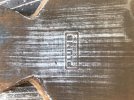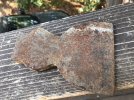- Joined
- Mar 15, 2021
- Messages
- 690
I got this hatchet head from my grandfathers old shop… it’s a Plumb Victory and guess (judging from other posts) it’s from post WW2. It looks to be chisel ground. Flat on one side and beveled on the other. I’d like to restore it and put a handle on it. I’ve never done this before. What type handle should i put on it? Straight, curved, length, type of wood? Thanks!










